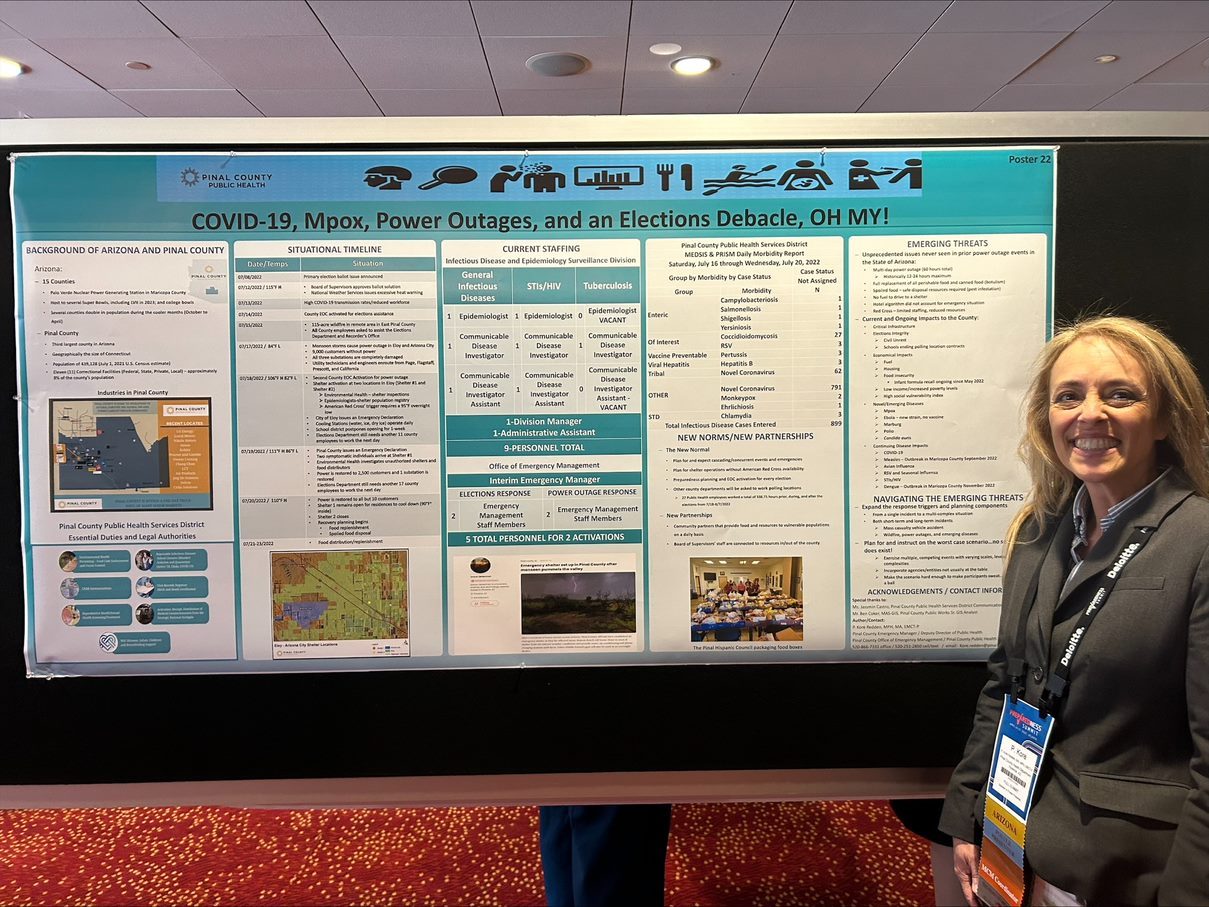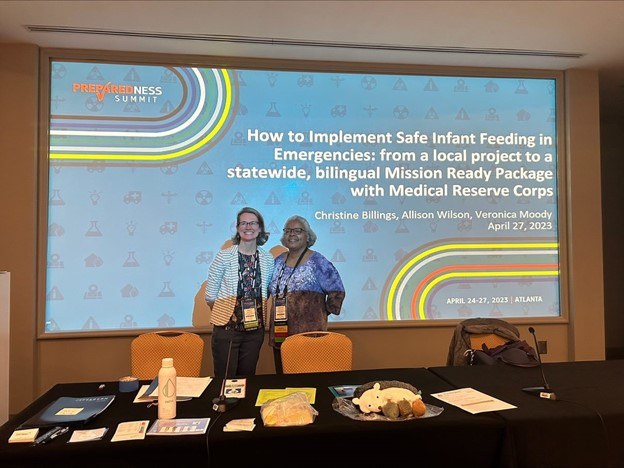Local health departments (LHDs) are critical in responding to public health emergencies. These institutions formed the backbone of the COVID-19 response and have also responded to infectious disease threats such as Zika, influenza outbreaks, congenital syphilis, and RSV. Many of these public health threats disproportionately impact pregnant people and infants, however, emergency preparedness and response (EPR) practices do not always integrate and prioritize specific maternal and child health (MCH) considerations. The COVID-19 pandemic and other related public health threats have demonstrated the need for dedicated resources to prioritize MCH populations within EPR efforts at the local level.
Overview of the MIP Project
NACCHO’s Bridging Maternal-Child Health (MCH), Infectious Disease (ID), Preparedness, and Birth Defects within Cities and Counties (MIP) project, funded through CDC’s National Center on Birth Defects and Developmental Disabilities, was initiated to help address gaps in EPR planning and activities for MCH population needs. This project supports public health and clinical care partnerships at the local level to increase local jurisdictions’ ability to protect, respond, and support pregnant people and their infants from emerging threats. To support these efforts, NACCHO convened the MIP Collaborative Workgroup and selected three LHDs to serve as MIP Demonstration Sites.
Details on the MIP Collaborative Workgroup
The MIP Collaborative Workgroup is a peer-to-peer learning opportunity comprised of LHD officials and staff from across the country with expertise and interests in the intersectionality of preparedness, ID, MCH, and/or birth defects. MIP Workgroup members convened virtually on a bi-monthly basis to identify variations, gaps, and promising practices in coordinating response and surveillance of the impact of infectious diseases on pregnant people and infants; identify and design tools to support LHDs with responding to and managing the impact of infectious disease on MCH populations; and draw from lessons learned in previous infectious disease preparedness practices. The following LHDs participated in the 2022-2023 Workgroup year:
- Austin Public Health (TX)
- Brazos County Health District (TX)
- City of Minneapolis Health Department (MN)
- Florida Department of Health Broward County (FL)
- Florida Department of Health Sarasota (FL)
- Fort Bend County Health and Human Services (TX)
- Harris County Public Health (TX)
- Jefferson County Public Health (CO)
- Los Angeles County Department of Public Health (CA)
- Pacific County Public Health & Human Services (WA)
- Pinal County Public Health Services District (AZ)
- Saint Louis County Department of Public Health (MO)
- Sauk County Health Department (WI)
- Stanislaus County Health Services Agency (CA)
- Warren County Health District (OH)
NACCHO’s MIP Collaborative Workgroup members have been a vital part of the MIP project and have had unique opportunities to present their subject matter expertise at conferences. For example, two Workgroup members had the opportunity to present at NACCHO’s 2023 Preparedness Summit in Atlanta, GA. Kore Redden, from Pinal County Public Health Services District in Arizona, discussed her work simultaneously navigating the ongoing COVID-19 pandemic, the emerging threat of Mpox, a 3-day power outage in 100+ degree weather, and an early ballot print failure during an election.

MIP Workgroup member Kore Redden from Pinal County Public Health Services District in Arizona presented her work at NACCHO’s Preparedness Summit earlier this year.
Allison Wilson, from Jefferson County Public Health in Colorado, presented her health department’s efforts to strengthen safe infant feeding in emergencies. The session discussed how Jefferson County Public Health, the Rocky Mountain Medical Reserve Corps, and other partners throughout the state of Colorado collaborated to integrate pregnant people, families, and young children into emergency preparedness planning through volunteer training, safe infant feeding kits, and updates to the health department’s emergency guidance. Allison and her team’s work will also be featured in an article published in the summer edition of the NACCHO Exchange, NACCHO’s quarterly print newsletter.

MIP Workgroup member Allison Wilson from Jefferson County Public Health in Colorado presented at the 2023 Preparedness Summit about her health department’s efforts to strengthen safe infant feeding in emergencies.
Local Health Department Demonstration Sites
As part of the MIP project, NACCHO selected three LHDs -- Brazos County Health District (BCHD) in Texas, Fort Bend County Health & Human Services (FBCHHS) in Texas, and Los Angeles County Department of Public Health (LACDPH) in California -- to serve as MIP Demonstration Sites and develop projects to improve outcomes for MCH populations at the local level. NACCHO, in partnership with the Center for Public Health Innovation at CI International, facilitated virtual action planning processes to support these health departments in identifying priorities for cross-disciplinary collaboration and increasing prioritization of pregnant people and infants in their jurisdictions.
At the start of the project, each participating demonstration site assembled a project team that comprised staff from MCH, ID, and EPR divisions at their LHDs. A pre-assessment was administered to determine each LHD’s capacity for meeting the needs of MCH populations during emergency response, specifically for infectious disease threats. This assessment also measured each LHD’s level of collaboration among MCH, ID, and EPR at their organizations before initiating project activities. After the assessment, between January and May of 2023, NACCHO supported the LHDs to develop project action plans to guide their work.
Why Start with Action Planning?
A project action plan outlines in detail the steps needed to achieve a project’s goals and objectives. Developing an action plan involves determining project goals and objectives, identifying stakeholders and partners, defining specific action steps and timelines, continually reviewing progress, and adjusting goals, objectives, and action steps as needed.
After listing these steps, an action plan should also answer the following questions about the project or initiative:
- What needs to happen?
- When should it be done?
- What resources are needed?
- Who is doing what?
For those interested in incorporating an action planning process into their own work, a project plan action plan template can be found here.
MIP Demonstration Site Action Plans
The following table includes information about the project action plans developed by each demonstration site. The information has been broken down by the goals and objectives set by each LHD and the stakeholders and partners involved in their projects.
| Name of LHD | Goals | Stakeholders/Partners | Objective set |
|---|---|---|---|
| Fort Bend County Health & Human Services (FBCHHS) |
|
|
|
| Los Angeles County Department of Public Health |
|
|
|
| Brazos County Health District (BCHD) |
|
|
|
Future Directions
The MIP project aims to address gaps and inequities in public health responses that are impacting MCH populations by providing resources and technical assistance to LHDs. NACCHO hopes to continue efforts to strengthen collaboration between MCH, ID, and EPR to ensure MCH populations are supported during emergencies. For questions or more information, please contact Elana Filipos ([email protected]) and Harpur Schwartz ([email protected]).



